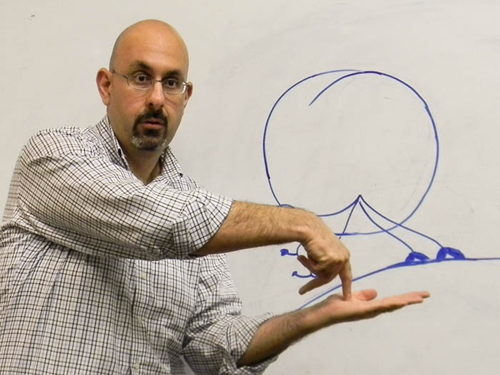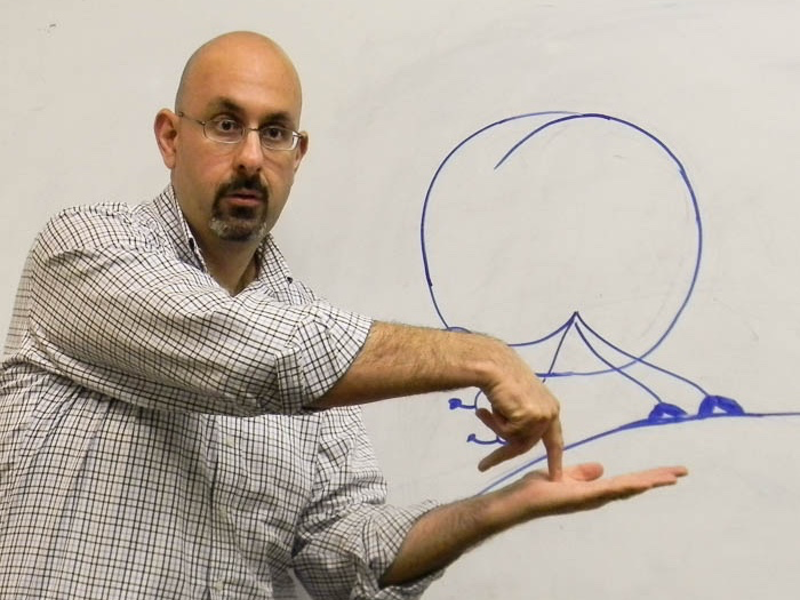Q&A: Inside a Cell’s Engine Room
Life is hectic inside a living cell. To keep a cell functioning, myriad processes such as protein synthesis, power generation, waste disposal, and DNA replication are constantly and simultaneously running. These processes all rely on the precise and coordinated transport of organelles, proteins, and other biomolecules to the places where the cell needs them. George Shubeita, a professor of physics at New York University Abu Dhabi, studies the mechanisms by which tiny molecular motors move these cargoes. He observes the motors with superresolution microscopes and uses optical traps, commonly known as optical tweezers, to engage the motors in a “tug-of-war” game that allows him to measure their strength. In a conversation with Physics, Shubeita explains how he applies the techniques to uncover the secrets of how these motors function within the crowded environment of a living cell.
–Matteo Rini
Matteo Rini is the Deputy Editor of Physics.
What are molecular motors?
Molecular motors are the workhorses of cells. They are proteins that convert chemical energy into mechanical work, which they then use to drive muscle contraction or DNA replication, among other things. My research focuses on motors that carry cargoes around the cell. These motors have a “trunk,” “feet” for walking, and “arms” with which they grab their consignment. Motors step along filaments—long protein chains that, just like streets in cities, serve as pathways towards their destinations.
What cargoes do the motors transport?
Motors carry everything from proteins to organelles to mitochondria. In neurons, for example, they transport synaptic vesicles, which store neurotransmitters—chemical messengers that carry signals across synapses. Neurons can be very long—the longest neurons in our bodies are one meter in length and connect our spine to our feet. If vesicle transport along these longest neurons occurred by diffusion, it could take more than a lifetime for the vesicles to move from one end of the neuron to the other. Taking about 100 tiny steps per second, the motors can instead deliver them within a day.
How do you measure the motors’ strength?
We play “tug of war” with them. Using optical tweezers, we pull a cargo—typically a lipid droplet—as a motor attempts to move it. This method allows us to measure the forces exerted by the motors both in isolation—in buffer solutions that contain the minimal constituents to keep the motors functioning—and, more interestingly, in the complex, fluctuating environments of real cells. Thanks to such tug-of-war experiments, we measured, for the first time, the force of a single motor acting in a living cell and demonstrated that, more often than not, two or more motors cooperate to move the same cargo.
So how strong are they?
Motors are feeble! They exert just a few piconewtons on their cargo, a force that is roughly equivalent to the strength of a fleeting hydrogen bond. But that’s plenty for what they need to do. And they are extremely efficient in terms of energy consumption—I’d say about twice as efficient as the best car engine on the market.
What happens when these motors break down?
Defective motors can impair several cell processes and are associated with a number of diseases, although it’s often hard to assess if they are the disease’s cause or the effect. Given the length of neurons, their functions can be particularly affected—motor failure is a common factor in neurodegenerative diseases. Currently, we are investigating how the enzyme GSK-3, which is excessively active in Alzheimer’s patients, impairs motor transport in neurons.
Did you find out anything relevant to Alzheimer’s research?
Our experiments show that GSK-3 reduces the activity of certain molecular motors that transport cargoes along neurons. We are working to understand why and how this happens at the molecular level. Such information could provide a more rational basis for the design of therapeutic drugs that target the disease by inhibiting GSK-3.
After that, what’s next on your research to-do list?
There are only a handful of distinct kinds of motors in a cell, yet there are hundreds or thousands of different cargoes that need to be delivered simultaneously to different parts of the cell. I would like to understand how the cell achieves such a well-coordinated transport. Part of the answer will involve physical mechanisms that our experiments are well suited to probe. For example, one hypothesis is that the cell may modify the “roads” on which these motors move to redirect traffic.
What hooked you to this research topic?
We know more about how the Universe started and galaxies formed than about how I can wave my hand. It’s fascinating to try to solve the puzzles of biological life.
Know a physicist with a knack for explaining his or her research to others? Write to physics@aps.org. All interviews are edited for brevity and clarity.





